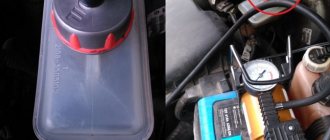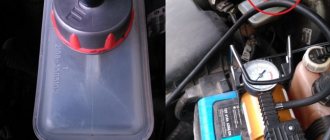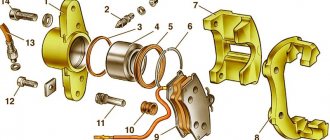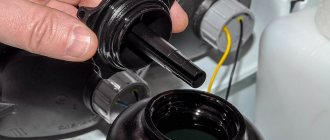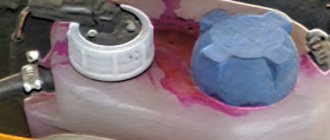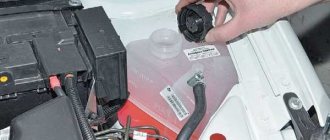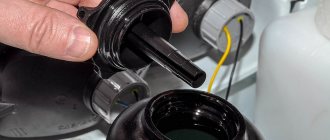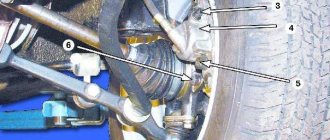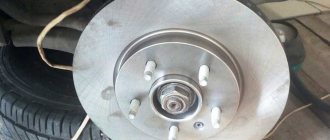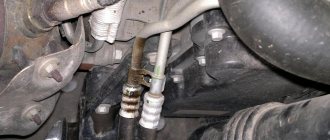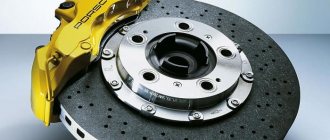The design of the VAZ 2107 car uses a braking system, on the serviceability of which the safety of the driver and passengers depends. This system consists of a large number of different parts, and an important role is assigned to the brake fluid reservoir of the VAZ 2107. This is a special container into which a special liquid mass is poured, which takes an active part in the operation of the system.
Where should I pour the liquid?
In order to fill this same liquid, you first need to find a tank for it. By the way, many cannot find it the first time and without outside help. Before you fill in a new fuel fluid, you need to get rid of the old one. To do this, use a syringe or similar means to clean the tank, and then use any clean cloth to remove the remaining sediment on its bottom and walls.
It is clear that this liquid must be poured very carefully, since contact with the exterior paint of the car can lead to damage. If you do not properly clean the reservoir of the previous brake substance, then small particles such as dust in the future may well cause a complete failure of the corresponding system. If the level of the substance in the reservoir is low, it is necessary to immediately check the integrity of the brake hose, as the cause may be a leak.
In general, the braking system is considered closed, although air enters it when the brake pedal is pressed, but it is completely pushed out when it is smoothly released. This feature of the system allows the liquid to be stored for a very long time and it is recommended to replace it only after two or even three years.
It's no secret that all substances need timely replacement. All necessary data is usually collected in the vehicle's operating manual. In addition to time, another factor in the need to replace brake fluid is mileage.
After driving forty thousand kilometers, you need to at least check the serviceability of the braking system.
Brake fluid for VAZ 2107
The brake system of a VAZ 2107 car consists of discs, calipers, main and working cylinders, pads, pipes inside which brake fluid flows (hereinafter referred to as TF).
The quality of braking depends on the service life of the fluid, cleanliness, and sediment. The European Motorists Association explains that in 28% of accidents the cause is a faulty brake circuit (BC). The indicator is above the average for the CIS countries and the Russian Federation, among others.
Replacing (renewing) the fluid on your own is not at all difficult, but be extremely careful not to violate the established regulations. Otherwise, you risk damaging the seals and working cylinders on the caliper.
What brake fluid should be used on a VAZ 2107 car
The design of the TC is as follows: a caliper is installed on each wheel, inside of which there are two brake pads. They compress the disc when you press the pedal. The pressure inside the circuit increases, which is transmitted by the fuel fluid to the working cylinders and pads.
After the driver releases the pedal, the pressure in the circuit is restored, the disc and pads return to their original position. During operation of the machine, due to temperature changes, sediment forms in the liquid, the circuits become clogged, and obstacles are created to the natural circulation of the “lubricant”. Highways require urgent maintenance, cleaning, and replacement of sealing elements.
Cars of the VAZ 2107 family are required to be fueled with DOT-4 class diesel fuel based on synthetic and semi-synthetic bases. Mineral is excluded from use.
Until 1995, DOT-3 was filled into the VAZ brake circuit. Due to low technical characteristics and non-compliance with modern requirements and standards, the third class was excluded.
AvtoVAZ engineers recommend updating the TZ every 45,000 km or three years from the date of refueling, whichever comes first.
The 4th – 6th generation bunkers have one drawback – active absorption of moisture and condensate. This is explained by the peculiarities of the hygroscopic structure at the molecular level. The more water absorbed, the fewer nutrients inside, the weaker the structure.
The “boiling point” of DOT-4 is 250°, after the vehicle has run 60 thousand km. 130°. A low “boiling” threshold is one of the factors creating an emergency situation on the roads, jamming of calipers and working cylinders.
Note to the driver. Do not mix synthetic, semi-synthetic and mineral based fuels with each other. As a result of a chemical reaction, the liquid coagulates, forming a thick, homogeneous mass that will clog the circuit lines.
Review of Manufacturer Prices
Name / catalog article of brake fluidPrice in rubles
| DOT4 250ml TRW PFB425 | From 145 |
| DOT5.1 250ml TRW PFB525 | From 180 |
| DOT4 500ml TRW PFB450 | From 220 |
| DOT5.1 500ml TRW PFB550 | From 220 |
| DOT5.1 ESP 500ml TRW PFB750 | From 220 |
| DOT4 1L TRW PFB401 | From 220 |
| DOT5.1 1L TRW PFB501 | From 220 |
| DOT4 ESP 1L TRW PFB440 | From 220 |
| DOT4 ESP 1L TRW PFB440 | From 220 |
| DOT4 5L TRW PFB405 | From 220 |
| *prices are as of May 2021 |
How does braking occur in a VAZ 2107
After pressing the brake pedal, the pressure inside the system increases, kinetic energy is transferred from the pedal to the working cylinders. As a result, the pads and disc are compressed, the car slows down and stops.
A fuel fluid that has lost its properties often leads to brake failure, jamming of the working cylinders, and depressurization of the circuit. When driving at high speeds, this is fraught with an emergency situation, a collision with oncoming traffic.
Note to the driver. Carry out preventive work with gloves. TJ is an aggressive environment and causes allergic reactions when it comes into contact with the skin. Wash your hands with running water and soap.
The volume of fuel fluid recommended by the manufacturer in the VAZ 2107 is 1.0 liter. During the operation of a technical product, topping up is often required for various reasons. Buy DOT-4 with a reserve of at least one and a half liters in total volume. When purchasing, check the class type of base TZh. Do not mix synthetics with mineral ones.
DOT replacement scheme - 4
The effectiveness of the brake circuit depends on the accuracy of compliance with the given sequence.
Violation of the scheme does not guarantee full functionality of the TC.
How to properly fill brake fluid on a VAZ 2107
3 flushes are enough to completely update the system. After each cycle, replenish the missing amount of DOT - 4 in the expansion tank. After updating the contour of one working cylinder, we move on to the next. DIY replacement completed.
We pump the front and rear brake circuits according to an identical scheme; there are no fundamental differences.
Signs of brake fluid loss of quality
If one or more signs are detected, stop the car, turn off the engine, and inspect the brake circuit and master cylinder. Subsequent operation of the technical device is unsafe.
Brake fluid reservoir location
The brake fluid reservoir is located in the engine compartment of the vehicle. In order to see it, you need to open the hood. The tank is usually located in an easily accessible, visible place. This is due to the fact that during the operation of the car the brake fluid level should be periodically monitored, topped up or changed.
ATTENTION! A completely simple way to reduce fuel consumption has been found! Don't believe me? An auto mechanic with 15 years of experience also didn’t believe it until he tried it. And now he saves 35,000 rubles a year on gasoline! Read more"
Brake fluid reservoir location
Still, there are cars where the tank is not so easy to detect. It is hidden in the depths of the engine compartment and is often covered with decorative panels, other components or parts. To find the tank in this case, it is recommended to refer to the technical description of the specific car.
Brake fluid reservoir hidden from easy access
How and when to change brake fluid on VAZ cars
The automobile braking system can be called one of the most important in the operation of a car, because without it more than one vehicle cannot exist.
Therefore, for the brakes to function flawlessly, it is necessary that the system elements be reliable.
Not every car enthusiast knows that the fluid in the brake system needs to be changed from time to time. Some people believe that it is only necessary to periodically top up the brake fluid so that air particles do not appear in the system, which will impair the performance of the brakes.
However, this opinion is not entirely correct, although you should not refuse this operation. The fact is that during the operation of the car, moisture forms in the brake system drive, which is safely absorbed by the brake fluid .
The presence of moisture in the fluid is no less dangerous than the presence of air in it, since the operation of the braking system in this case becomes ineffective and undergoes corrosion.
Based on this, it is recommended that the brake fluid be replaced not only according to the manufacturer’s recommendation, but also when moisture and air in it are independently detected.
How to determine if your brake fluid needs to be replaced
As a rule, the manufacturer, in the list of work performed during scheduled maintenance, determines its brake fluid replacement interval for each vehicle individually. For example, on VAZ cars this interval is 45,000 km. mileage or at least after three years of operation.
The replacement period may also be affected by the type of brake fluid and the design of the brake system. However, car owners are recommended to carry out visual inspection of the fluid from time to time, and they should pay attention to its color.
If, looking into the brake fluid reservoir , you see that it has a dirty tint, this indicates that some elements of the brake system drive are worn out; therefore, in this case, a complete diagnosis is recommended.
If the liquid has a brownish tint, this is a sign that it contains water. In any of the above cases, the brake fluid needs to be replaced .
What kind of brake fluid is needed for a VAZ
All brake fluid has its own classification, which indicates its composition and properties. At the moment, there are several brands of TJ - DOT 3, 4, 5 and 5.1. There is also another outdated type of brake fluid BSK, which is still used on older cars.
Is it possible to mix brake fluids?
Theoretically, brake fluids are based on the same component, for example, DOT 3, DOT 4, DOT 5.
1 contains glycol and must be mixed, however, due to the presence of a certain set of additives in them, this can only be done in extreme cases, after which a complete replacement of the brake fluid is mandatory.
You cannot use TJ in a brake system that is designed for a certain type, for example a DOT 5 fill, which is made on a silicone basis; in a system for DOT 3, DOT 4, DOT 5.1, rubber drive elements (cuffs, seals) may fail.
Key words: brake fluid , brake fluid replacement , VAZ brake fluid , brake fluid reservoir , what kind of brake fluid , dot , brake fluid dot 4 , brake fluid dot
How to find it in Hyundai?
When using a Hyundai car, you need to periodically check the volume of brake fluid. If necessary, add fluid to the tank. The reservoir into which the brake fluid must be filled is located on the main cylinder, on the left side of the engine compartment.
In order to avoid the costs of repairing the brake system, or even the entire car, in the future, change the used working fluid with a new one in a timely manner . Brake fluid is highly hygroscopic (absorbs moisture from the air). This not only increases the corrosive effect on spare parts, but also reduces the boiling point of the liquid itself. This may cause the braking system to stop working. Do not re-apply the drill. It contains too much dirt, air and moisture.
We recommend: What is the difference between mineral oil and synthetic oil?
everything useful is here
Replacing brake fluid and bleeding the brake system
Bleeding the brakes is necessary after replacing the brake fluid, as well as to remove air that has entered the hydraulic drive during the repair or replacement of individual components of the brake system.
We do the work together.
We remove air first from one circuit, then from the other, each time starting from the wheel furthest from the main cylinder.
To bleed the front circuit, we hang up the front of the car, install stands and remove the wheels.
Remove the rubber protective cap from the bleeder fitting of the right wheel cylinder.
We put a hose on it (preferably transparent), lowering its free end into a suitable container. An assistant presses the brake pedal three to four times at intervals of one to two seconds and holds the pedal down.
Using an “8” wrench, unscrew the bleeder fitting 1/2–3/4 turn. In this case, part of the brake fluid and air are forced into the container, and the pedal is lowered to the floor. Air bubbles are clearly visible in the transparent hose or liquid. We tighten the bleeder fitting, after which the assistant can release the pedal.
We repeat the operation until the release of air bubbles from the hose stops.
When removing air from the system, you need to monitor the fluid level in the master cylinder reservoir and add it if necessary.
Similarly, remove air from the brake cylinder of the left wheel.
When completely replacing the brake fluid, we pump until new fluid comes out of the bleeder fitting (it is lighter in color).
It is more convenient to perform bleeding of the rear circuit on an inspection ditch or a lift. To eliminate the influence of the pressure regulator on bleeding the brakes, we work with the rear wheels loaded (the rear axle is not allowed to hang out).
Lada VAZ 2107 is a domestic car with a long history. Despite the great competition, it does not give up its position and occupies a leading position in sales in the secondary market. Today, almost two million Russians own a S7.
The car is presented in a sedan body. Rear-wheel drive. The gearbox is mechanical. There are ten modifications. Their main differences are in power plants and restyling.
Purpose of the container
The design of the domestic VAZ 2107 car uses a hydraulic braking system, consisting of drive and actuator mechanisms, as well as lines in the form of tubes and hoses, and a reservoir filled with liquid. This liquid substance acts as a drive source, and it is called brake fluid - an acid that is hygroscopic. It is poured into a transparent plastic container under the hood, but more on that.
The container in question on the seven is made of soft and impact-resistant plastic. It is almost impossible to break the tank, but it is easy to damage it with a sharp tool. The reservoir is filled with fluid, which goes to the master cylinder. The piston moves in the cylinder when the middle pedal is pressed, thereby increasing the pressure in the system. When the pressure increases, the working cylinders are activated, in which the pistons move under the action of a liquid substance.
From a brief description of the principle of operation of the brake system on the VAZ 2107, it is clear that the reservoir plays a fundamental role. It ensures an uninterrupted supply of working substance to the main cylinder of the system. If lines or operating mechanisms are damaged, the tightness of the system is compromised. Due to the fact that the tank has transparent walls, it is possible to identify system malfunctions easily and quickly. To do this, you need to open the hood and look to see if the container is full.
How to change the tank
Before replacing the brake fluid reservoir, you need to understand its location. The reservoir is located on the driver's side under the hood. When you open the hood, you need to look at the wall closest to the cabin, where there will be two plastic tanks next to each other. The first reservoir, which is located to the left, is a container for brake fluid. Next to this tank there is another tank of a smaller volume - this is a container for a similar substance, which is used in the clutch system.
Vehicle owners should be aware that brake fluid must be replaced every 40 thousand km. If the car has mileage above this indicator, then the quality of the mixture deteriorates, which can cause brake failure at any time. In addition to replacing the mixture every 40,000 km, it is also necessary to periodically monitor the level of brake fluid in the reservoir and, if necessary, top it up.
Signs of brake fluid loss of quality
- Increasing the length of the path to a complete stop of the car;
- Pressing the brake pedal requires force;
- The pillbox in the expansion tank changed color from light to dark;
- At the place where the tank is installed, traces of lubricant leakage are visible, the level is below normal;
- The yellow indicator on the dashboard indicates the fluid level sensor in the system.
If one or more signs are detected, stop the car, turn off the engine, and inspect the brake circuit and master cylinder. Subsequent operation of the technical device is unsafe.
The VAZ 2107 has been the sales leader on the Russian market for many years. Since its production ceased in 2012, today only a used version can be purchased.
The car is popularly known as the seven. It is a 4-door, 5-month vehicle with rear-wheel drive and a manual transmission. It was produced in several modifications, which differed in engines and restyling.
The manufacturer took into account the peculiarities of Russian roads and created a car that can easily withstand all bumps and potholes. Its ground clearance is quite high, which has a positive effect on cross-country ability. Thanks to rear-wheel drive, the car has excellent maneuverability and good road grip. This is explained simply. When the gas pedal is pressed, weight is transferred to the rear.
The car has two important advantages: affordable cost and low maintenance. There are no problems with purchasing parts, spare parts and consumables. They are presented in a large assortment on the modern market. Moreover, their cost is low.
In addition, the VAZ 2107 boasts a spacious interior, a roomy trunk, comfortable front seats, good visibility, faceless dials and a soft spring suspension that ensures a comfortable ride.
Fluid replacement tips
Now that we have figured out where exactly it is necessary to fill the fuel fluid, the next step is to choose between contacting the service or replacing it on our own, but not without an assistant. Of course, every more or less high-quality and serious car service center has all the necessary equipment to perform such a braking operation. Thus, the replacement time will be no more than twenty minutes, and its cost will not be too high. Manual replacement takes up to two hours.
Having determined where the brake fluid reservoir is located, first of all, use a tester to check its quality. For example, electronic testers immediately show the boiling point of the fuel fluid, and if it exceeds one hundred and seventy-five degrees Celsius, then everything is fine, but if it is below one hundred and sixty-five, then things are bad and intervention is required.
You also cannot do without an instruction manual, because each car has its own characteristics, and thanks to it you will understand how and where to fill the fluid. But you need to understand that if your car does not include an ABC or a block of corresponding ABC hydraulic valves in its structure, the hydraulic accumulator and pump itself are a single unit, manual intervention is quite possible. If you have an integral type ABC, it is best to visit a car service center.
We recommend: Electrolyte for batteries
Replacing an old vehicle with a new one is carried out carefully and one by one in the circuits of the vehicle. The first in line for this process is the wheel located away from the main cylinder of the vehicle. Therefore, there is a parallel circuit diagram and a diagonal one. The first is a replacement of the TJ in the right rear wheel, left rear, right front and left front. As for the diagonal scheme, the procedure is carried out diagonally: right rear - left front and left rear - right front.
Before adding new fluid, all wheels must be removed, and the car itself must be placed over a pit for inspection. Using a jack, you can also carry out all stages of repair, but the convenience of the process directly depends on the position of the brake cylinder bleeder fittings.
Having removed the wheels and figured out where to fill the brake fluid, the next step is to pour it into the reservoir to the full line and replace the cap. After this, you need to pump the brakes by pressing the pedal at least fifteen times so that the fuel fluid spreads throughout the entire system.
In general, for a complete repair it is necessary not only to find out where the brake fluid reservoir is located, but also to acquire the following things:
- Two pairs of stand-up goats;
- Box type wrench;
- Completely clean plastic pipe;
- High-quality TZ;
- A syringe or other suction device;
- Brake cleaner;
- Clean and fairly soft fabric;
- Container for old liquid;
- WD-40.
Replacing brake fluid on a VAZ Classic
Timely maintenance of your vehicle will help you avoid serious breakdowns and accidents.
In the video and article we will talk about replacing brake fluid.
It should be noted that even many Germans drive with expired brake fluid. What then can we say about car enthusiasts from Russia? Many drivers encounter a car in front with one, or sometimes two, inoperative brake lights. It is completely unknown what is splashing in the brake systems of these cars, it’s scary to imagine.
Some fearless drivers can drive without brakes at all, but sooner or later life will punish them for such negligence; there are simply a lot of surprises on the roads. The brake system is one of the most important components of any car, which ensures safety.
Disadvantages of old brake fluid
Please note that brake fluid is hygroscopic. The liquid that has accumulated water boils at lower temperatures. For fans of high-speed driving on a hot day, it is enough to brake sharply a couple of times for the brake fluid to boil. In addition, the effectiveness of the brakes decreases.
This primarily provides favorable conditions for the development of corrosion. Even if the brake cylinders look good externally, but when braking the car pulls to the side, remember when you changed the brake fluid.
A fluid with a low boiling point is used in drum brakes of low-speed vehicles. Also look at the presence of various additives, including anti-corrosion ones. It is recommended to use DOT 4 fluid.
It is believed that it is very difficult to replace brake fluid on a VAZ alone - this is why many people delay it. We will prove that this is not so. It will take approximately 1.5 hours of time, a tool and ingenuity.
Step-by-step instruction
1. Unscrew the fittings
Use auxiliary fluids first if you are overdue for fluid replacement. It is also recommended to first remove all fittings. The liquid will begin to drain. The main thing is to look into the tank more often - it should be full.
2. Flush the system
Access to the tank on a Zhiguli is quite simple. It is divided into two circuits. Be sure to purchase two cans of liquid. One is for flushing and the other is for filling. The old fluid replaces the old one and flushes the system at the same time.
Approximately 150 grams per wheel should be poured onto the front circuit. On the rear - a little more.
We speed up the process and improve washing
To do this you will need a homemade device. To do this you need to remove the spare tire. You will also need a hose of a suitable size and a cover from the clutch reservoir with a slight modification: a nipple from a tubeless tire without a nipple and a homemade rubber gasket are embedded into it.
Inflate the wheel to approximately 2 atm. Unscrew the nipple and put on the hose, which must be twisted with wire to prevent air from leaking out. Attach a cap to the other end of the hose and screw it onto the brake reservoir, which is filled to the top with brake fluid. All bleeder fittings must be screwed in.
You can unwind the wire. The pressure created will speed up the process. As a result, it is not necessary to put a hose on the bleeder fitting - the pressure is excellent.
As soon as the liquid becomes clear, it means that the circuit is ready. Wipe everything thoroughly with a cloth, and you can generally cover the fitting with plasticine - next time it will be easier to unscrew.
Then you can change the fluid and bleed the brakes alone.
Where is the brake fluid reservoir located?
In the domestic VAZ car, the brake fluid reservoir is located in the engine compartment (on the left) and is secured with a clamp to the partition. A decrease in the volume of working fluid in the reservoir when the hydraulic brake drive system is sealed is a sign of worn out pads.
Knowing where the brake fluid reservoir is located, you can easily replace the brake fluid with fresh fluid. Remember to replace regularly. Thanks to this, you can maximize the operating life of your own machine.
General structure of the vehicle
The diagram of the brake system of the VAZ 2107 car consists of two main components - the drive mechanism and the brake actuators. Due to the drive mechanism, a braking signal is sent to the actuators, thereby bringing the vehicle to a complete stop or reducing the speed.
Braking is performed by increasing the friction energy of friction units with rotating parts. The brake system of the VAZ 2107 is designed in the traditional version:
- The front part is implemented through the use of disc brakes, which are considered one of the most reliable.
- The rear part is equipped with drum devices, the operation of which is also based on friction force.
The brake system drive can be of different types, but the seven uses exclusively a hydraulic type. The hydraulic drive system uses fluid, which acts as the basis of the VAZ 2107 brake system. Brake fluid has the necessary characteristics and is used as a conductor to transmit force from the brake pedal to the actuators - the pads.
